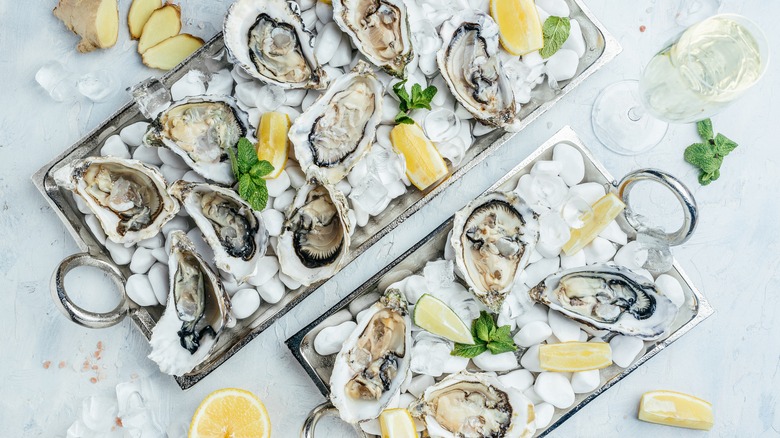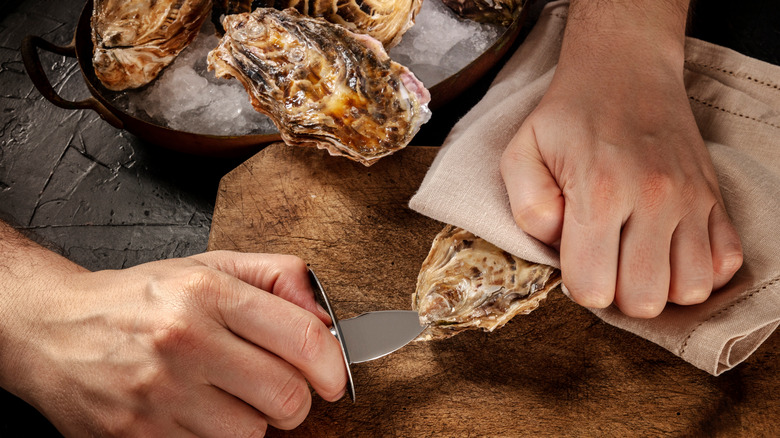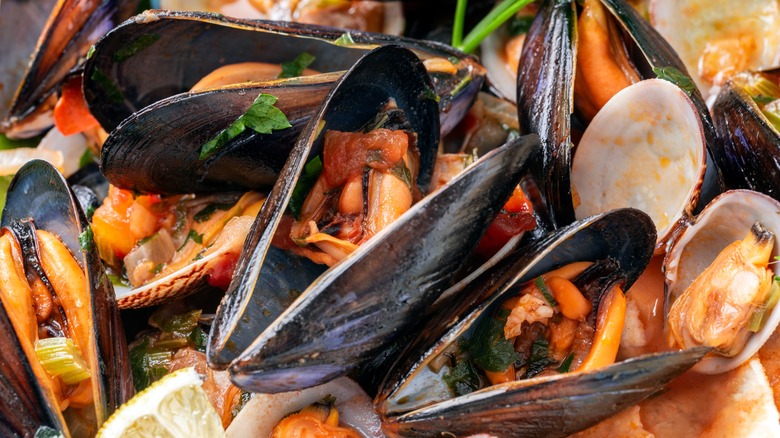The Sign You Should Skip Ordering Oysters At A Restaurant
When it comes to seafood, it's no secret that the fresher it is, the better. Oysters in particular are best kept alive until they are ready to be shucked and served, and these coastal delicacies can then be enjoyed right off the shell or as part of a tempting oyster shooter. A bad oyster, though, can lead to a gnarly case of food poisoning, so it's important to understand what to look for and how to avoid a shellfish that might be past its prime.
One major sign to avoid ordering oysters in a restaurant is if you are aren't dining near the coast. At those inland eateries, it's best to steer clear of the raw seafood selections. If your oysters had to travel more than 100 miles from the tides to your table, you probably don't want to gamble your health on the meal. There are eight kinds of food poisoning to know, and some cases can unfortunately be deadly.
Healthy oyster meat should look glossy, fat, and full, with a light tan hue. An oyster that has spoiled might appear brownish, grey, black, or even pink. It may also look cloudy or withered and dry. A freshly shucked oyster will still be soaking it its own juices, known as oyster liquor. This is the liquid that keeps an oyster alive in its shell and is a reassuring sign for those judging an oyster's quality. They should have a customary salty aroma but not be overly fishy. Crucially, though, be aware that oysters don't always smell differently whether they're good or bad. When in doubt, trust your senses, and avoid ordering raw shellfish if you can't smell the sea.
Checking oyster quality at home
If you're skipping the restaurant risks and preparing oysters at home yourself, there are a few tricks to check the health and quality of your haul. The shells should be bright and glossy with grey and pinkish streaks. Shells that are green or overly browned should be tossed out. The shells should be closed firmly with no gaps or holes. If an oyster is open, it should quickly close when touched or tapped. Closed oysters should also be tap-tested, either against each other or with your shucking knife. Healthy oysters sound solid, like rocks. Hollow-sounding oysters are likely not tightly sealed or have already gone bad. Don't risk it with them. They've already gone to the big tide pool in the sky and have no place on your plate.
If you don't plan on eating or cooking your oysters right away, they need to be stored in a cool, moist environment. You can wrap them in a damp cloth and keep them in a refrigerator. Make sure they are stored with the more rounded shell down so that they can soak in that oh-so-important liquor that keeps them alive. Since they are still living and breathing, they should not be kept in an airtight container, lest they suffocate before you can enjoy them. Whether you are cooking them up or shooting them raw, there are so many way to enjoy these briny fruits de mer — as long as they are fresh.
Safe shellfish are closed until cooked
Unlike other animal products that can be safely kept for some time after an animal's slaughter, dead shellfish are considered unsuitable to eat. And this applies to more than raw oysters. Clams and mussels can also be dangerous fare if they die in their shell before they can be prepared. Fresh shellfish's shells should be clamped shut and not open easily, but when shellfish are baked, boiled, steamed, or otherwise cooked, their shells naturally open and expose the meat. Any shellfish with a still-closed shell after cooking must be deemed unsafe to eat and thrown out, but some chefs aren't so careful. This is the main reason mussels were one of the seafood dishes Anthony Bourdain advised against ordering, as they can become a deadly dish if handled carelessly.
If you have any doubts about a restaurant's seafood, don't be shy to ask your server about the source and freshness of their stock. A reputable place should be able to tell you where and when they got their latest catch. Your server might not know off the top of their head, and that's fine, but they should know where to get that information. And while it's nice to have a nautical treat that was caught same-day, when properly handled and refrigerated, Pacific oysters can sometimes live for 10 days or more in their shell. But because of the risks of mishandling during that time, it never hurts to check.



